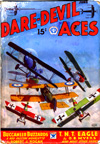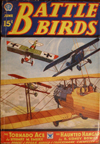“Green Horn Wings” by Frederick Blakeslee
Frederick Blakeslee painted the covers for Dare-Devil Aces‘ entire fourteen year run. He also painted all 17 covers of the first run of Battle Birds. When you’re doing all the covers, it’s easy to have a continuing story. As a special treat this week we have a three part story told over two months and two different magazines. We start with the May 1934 cover of Dare-Devil Aces and continue the story on the following month’s cover and on over to the same month’s issue of Battle Birds!
 THE COVER this month illustrates one of three exciting encounters described by a German flyer in answer to the question, “What do you consider your most exciting flight?” The author’s name is withheld by request. The other two encounters will be shown on the covers of BATTLE BIRDS and DARE-DEVIL ACES for June. The following has been translated by Mr. J.J. Hermann.
THE COVER this month illustrates one of three exciting encounters described by a German flyer in answer to the question, “What do you consider your most exciting flight?” The author’s name is withheld by request. The other two encounters will be shown on the covers of BATTLE BIRDS and DARE-DEVIL ACES for June. The following has been translated by Mr. J.J. Hermann.
“My most exciting flight? That is very easy to answer—my first front-line patrol.
“Just a word about my plane before I go on. All the ships in our staffel were painted in combinations of red, white and green, except the commander’s, which was all blue. My Albatros had red-tipped upper wings, black crosses on a white field, and the rest of the wing, fuselage and lower wing, was green. A red band encircled the fuselage, on which were black crosses. The fin and rudder were green and the elevator white. It was a beauty and I was immensely proud of it.
“Our commander, like Richthofen, was very severe with anyone who returned to the field with bullet holes in the tail of his machine. Every pilot in the staffel would rather be shot down then come home with holes in his tail.
“I received my instructions, which were to stick in formation and to follow the commander no matter what happened, unless we ran into an enemy formation. In that case, the leader was to rock his ship if he went to the attack, and I was to fly for home at once. They considered me too ‘air-blind’ to be of any use in combat. Of course, I couldn’t understand why any one should be ‘air-blind’, for certainly it would be easy enough to see an enemy plane. But I soon learned.
“I was flying close on the left of the leader, and was so engrossed with watching him that the whole enemy air force could have surrounded us without my knowing it. It was all I could do to keep my place in formation. I would throttle down when I seemed too close and then I’d get too far away and have to speed up only to get too close again. It was probably nervousness, for I had had no trouble in this respect in practice flights.
“I had been making heavy weather of it for perhaps twenty minutes when the leader suddenly dove. Ha, thought I, he is testing me. Down I went only to find that I was last in the formation. The three other planes were bunched directly in front of me. Turning to the left, I frantically tried to regain my position—and lost sight of the staffel at once. There I was as far as I could see, completely alone. The only thing was to go home, but that wasn’t so easy for I was absolutely lost. I was flying around in circles trying to locate the flight when to my surprise I found that I was again following my leader.
“It wasn’t until several hours later that I learned what had happened. When my leader dove it was to attack a lone Bre-guet. My awkward attempts to follow him disrupted the formation and spoiled his surprise move. He received a blast of fire from the French gunner, one bullet passing through his cheek and knocking out a few teeth. Then he saw me floundering around where I wasn’t supposed to be at all; breaking off the flight he picked me up and started for home.
“He looked at me to see if I saw him. I waved—I was determined not to lose him this time—and he began to climb, passing through clouds that covered what had been a cloudless sky. A minute later, he seemed to vanish again. Again I was alone and lost. . . .”
 “I THOUGHT I knew what had happened. My leader had executed these sudden maneuvers to test me—and I had failed. I determined to be on the alert next time.
“I THOUGHT I knew what had happened. My leader had executed these sudden maneuvers to test me—and I had failed. I determined to be on the alert next time.
“When I saw him go into another dive, therefore, I followed—and a split second later found myself alone again! Finally, after a frantic search, I spotted his Alba-tros high above me. Wondering how he got so high while I was flying so low, I climbed up and took my old position in the formation. This time my leader did not look at me, and a few minutes later we landed at our drome.
“To my surprise no other ships were on the tarmac. We were the first to return. With a sigh of relief at being safely home, but dreading the lecture on formation flying which I knew I deserved, I jumped out of my Albatros. It was then I realized that several men were lifting my leader out of his cockpit. Rushing over I was amazed to see that his face was covered with blood!
“The whole flight had been one surprise after another; but two more were still to come. One occurred a few minutes later when I discovered that the tail of my ship was full of bullet holes! How had they gotten there? While I was trying to figure that puzzle out, one of my missing patrol mates landed and handed me the second surprise by explaining what had happened during the short time I was in the air.
“After describing our encounter with the Breguet (pictured on last month’s cover) he went on. It seemed that my leader, seeing me floundering around instead of flying home and realizing I was a cold meat shot, broke off the flight, picked me up and started for home.
“A minute later an S.E. 5 hurtled straight through our formation. This was when I lost sight of my leader for the second time. The S.E.5 shot through like a mad comet, neither turning right or left, but blazing away with its guns. It is this amazing act of daring that Mr. Blakeslee has painted for the present issue of DARE-DEVIL ACES.
“One of our patrol was shot down  in control and another started in pursuit. The three of us that remained were almost home when we ran into a formation of Salmsons (see June BATTLE BIRDS cover). The leader of this flight shot down another one of our planes—also in control, luckily. The pilot returned two days later. The man shot down by the S.E.5 had to land in enemy territory and was taken prisoner.
in control and another started in pursuit. The three of us that remained were almost home when we ran into a formation of Salmsons (see June BATTLE BIRDS cover). The leader of this flight shot down another one of our planes—also in control, luckily. The pilot returned two days later. The man shot down by the S.E.5 had to land in enemy territory and was taken prisoner.
“Did I escape a lecture for getting my tail shot full of holes? By the time my leader was out of the hospital I had brought down my third enemy ship—but I got the lecture just the same!”

“Green Horn Wings: The Story Behind The Cover” by Frederick M. Blakeslee (May 1934)

“S.E.5 Hell: The Story Behind The Cover” by Frederick M. Blakeslee (June 1934)
Check back again. We will be presenting more of Blakeslee’s Stories behind his cover illustrations. This feature will move to Mondays starting in the new year when we will be featuring some of Mr. Blakeslee’s covers for Battle Aces!




